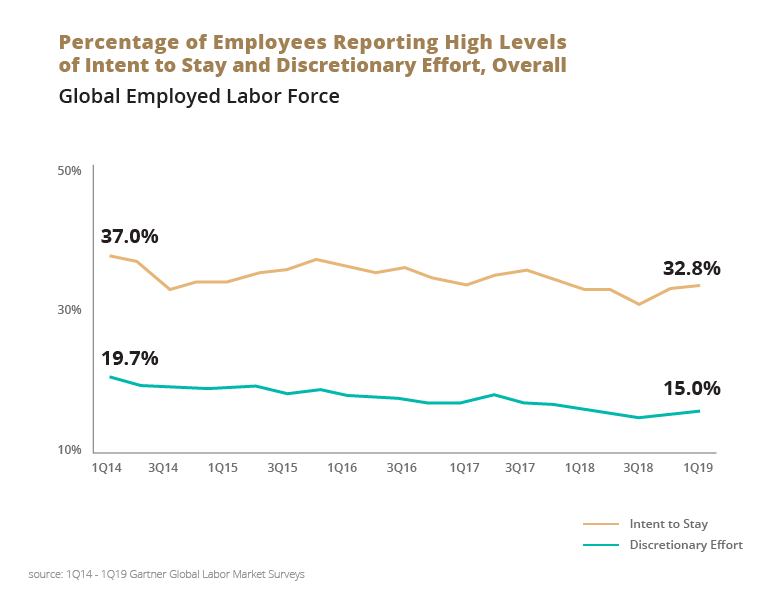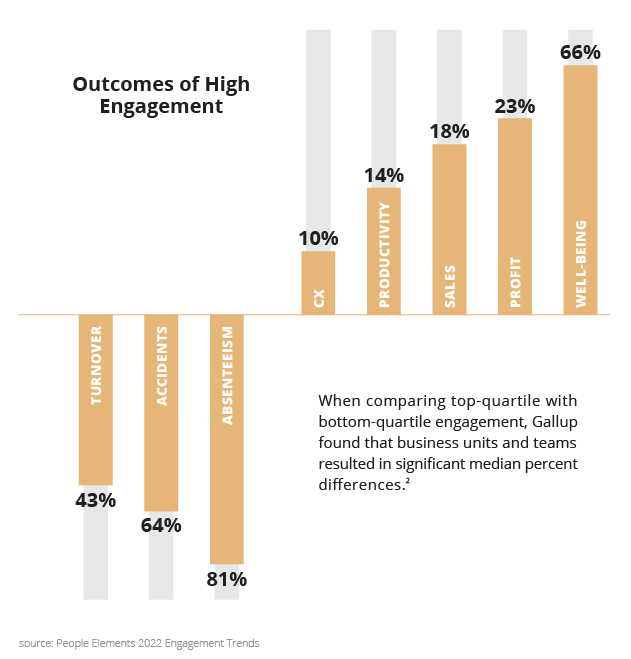< Back to insights
Published 03. Jun. 2022
How Does Good Employee Engagement Guarantee Organizational Success?
More than ever before, employee engagement is playing a bigger part in an organization’s success.
With the “Great Resignation” taking root as employees feel more dissatisfied with poor work-life balance, uninspiring jobs, and difficult managers, organizations are compelled to pay attention.
Globally, employee engagement has been low for the past 20 years, with employees’ intent to stay in their jobs hovering just above 30% according to Gartner’s Global Talent Monitor. Worse still, discretionary effort – going above and beyond the call of duty at work – has been on a steady decline, registering just 15% in 2019.
Unsurprisingly, employee engagement has taken a front seat in the strategic considerations of talent management leaders. However, even though about 90% of executives understand how important this is to an organization’s success, less than 50% know how to properly address the challenge. Especially in today’s technologically saturated workplace, ensuring employees are engaged can be a difficult and complex task.
What is Employee Engagement?
In order to address employee engagement, HR leaders must understand how it differs from employee satisfaction. The latter deals with the happiness of employees in their jobs which may have nothing to do with their sense of motivation, involvement, or emotional commitment to the organization.
The engagement metric takes a deeper look at employees, specifically their level of involvement and enthusiasm for work and at the workplace, says Gallup. This is a measure of how actively employees are involved with their work or if they are simply going through the motions of daily tasks.
Similarly, Gartner defines employee engagement as the measure of individual employee alignment with the organization and their willingness to go above and beyond the call of duty to achieve organizational goals.
The Impact of a Highly Engaged Workforce
Employee engagement is a key driver of performance, making it a crucial piece of the puzzle to organizational success.
Notably, People Element’s 2022 Engagement Report highlighted that companies with highly engaged employees show 81% less absenteeism and 43% lower turnover rates. Additionally, those companies also saw a 14% improvement in productivity, 18% increase in sales, and 23% increase in profits. The factor most affected was employee well-being which show a 66% improvement when employees are highly engaged.
Gallup’s State of the American Workplace report further reconfirms the data, showing that low employee engagement can cost companies up to $550 billion each year in the US. Additionally, the impact is seen on the business side as Gallup reported that higher engagement led to a 10% increase in customer loyalty as well as a 64% decrease in safety incidents.
Employee Engagement Markers
With that in mind, CHROs who are seeking to measure the level of engagement in their teams are facing the challenge of gauging human behaviors and perceptions which are incredibly complex.
CHROs and human resource leaders must consider a myriad of factors that contribute to an overall view of each person’s engagement levels within an organization. Generally, this is measured via an employee survey that is done regularly at all levels of an organization.
Existing measurement frameworks for employee engagement – such as by Gartner, Gallup, and People Elements – suggest several important markers that should be considered.
The first of these has to do with an employee’s understanding of their job as well as whether they receive adequate training, tools, and resources to perform their work well. Another relevant factor is whether employees feel that their work is important and connected to the organization’s overall mission. Employees that feel supported and valued tend to perform better.
Next, engagement increases if employees feel that they have a good relationship with their managers, they feel they are supported, and that management is invested in their professional growth and development.
Another core marker for engagement is an individual’s perception of senior leadership. Specifically, whether they believe the senior leaders are moving the organization towards a better future. Following that, it is also important to know if an individual feels that their own values align with those of the company. Employees who feel this alignment tend to perform better in their jobs.
As Chief People Officer at Anyfin, Amanda Pusa Edwall notes: “I have found both personally, but also from my job with HR that one of the most difficult things is when a candidate’s core values don’t align with the company. I think when that happens, it’s almost impossible to do a good job.”
Work conditions are another important driver of employee engagement. Particularly, it is crucial to find out if employees feel there is an effective feedback loop with their team managers, that everyone else on the team is equally committed, and that they receive adequate compensation and benefits. Also important is that employees feel that they have a work-life balance.
While Gartner suggests annual or biannual surveys to measure employee engagement, they note that many in HR feel that more frequent insights may be necessary and will utilize real-time analytics for this.
Analyzing HR and Business Metrics Together
Correlating employee engagement with other HR metrics such as performance ratings, attrition, turnover rates, and more will give organizations a better view of how engaged their workforce is. Leaders can then take proactive measures to address any issues or underlying causes of low engagement on a granular level.
Additionally, the measure of workforce engagement serves as part of a larger framework for measuring organizational performance. When tracked regularly, the data can help managers and business leaders make better decisions overall to improve their business metrics.
A clear example of this at work is when American retailer Best Buy calculated that an increase in employee engagement of just 0.01% is worth US$100,000, according to a Harvard Business Review study. This underlines how important it is for organizations to have effective strategies in place to create a better work culture that matches their employees’ expectations, thus improving employee engagement.
High employee engagement has been shown to reduce turnover, increase productivity, create better work and customer relationships, and ultimately have a positive impact on the company’s bottom line. It is up to HR leaders to come up with a strategy for employee engagement that best suits the needs of their organization and teams. What is your approach?


